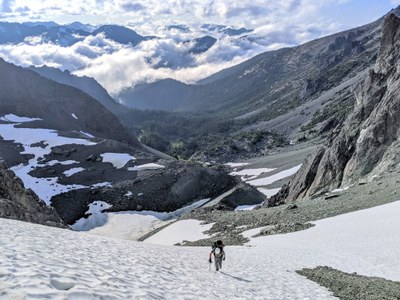
Trip Report
Alpine Scramble - Baldy—Gray Wolf Ridge—Mount Deception Traverse
A rigorous, sometimes-grueling, and unforgettably rewarding traverse full of breathtaking views and widely-varied terrain. Over four days and three nights we wound our way through a remote and challenging maze of ridges, valleys, basins, and cols, summited four peaks (Baldy, Gray Wolf, Gray Wolf South, and Deception), and, until the last day of the trip, saw no other humans.
- Fri, Jul 10, 2020 — Mon, Jul 13, 2020
- Alpine Scramble - Baldy—Gray Wolf Ridge—Mount Deception Traverse
- Baldy & Tyler Peak
- Scrambling
- Successful
-

- Road suitable for all vehicles
-
We spent most of Days 1 and 4 on-trail, and all of Days 2 and 3 off. Trail conditions were largely fine and involved nothing more inconvenient or hazardous than occasional blowdown on the Upper Maynard Burn Trail and a few slick rocks when crossing the creek near the trailhead. Off-trail conditions varied widely.The first patches of snow we encountered were on the slopes of Gray Wolf (Day 2) at about 6200'. Snow was spotty at and above this elevation until after we began our Day 3 ascent into the basin of Mt. Deception, where snow coverage became mostly consistent. We donned crampons shortly before ascending the basin's glacier at a spot where it narrowed to about twelve feet in height. The glacial ice was hard and slick, and to maintain stability we had to drive our ice axes and crampons in aggressively. Above the basin, the final approach to the summit was largely snow-free, though ascending the summit, itself, required crossing some thick, but non-hazardous, drifts and patches. We did wear crampons through most of the basin, but the only part of the route up Deception that truly required them was our short glacier crossing. The snow throughout the basin was of almost perfect consistency for climbing - well-consolidated but soft enough to kick good steps on the way up and plunge step on the way down.After Deception, the next significant snow coverage we encountered was going up the northwest side of Surprise Col. About half of this side of the col was covered in snow. It was somewhat harder than it was on Deception, but we felt secure without crampons. On the other side of the col, the snow was softer, covered the ground consistently, and made for a delightful glissade toward Royal Basin.
Mt. Baldy, itself, was an easy summit. We paused there briefly and enjoyed the views of nearby Tyler, Gray Wolf, and the larger, more-distant peaks of the northeast side of the Olympics. By this point, clouds had rolled in to the valleys and basins beneath us, including Royal Basin. We were above them, and the view of the ridgeline we'd continue along toward Gray Wolf was clear. Around this point, talk among us turned to where we would spend the night. We had three choices - descend to the small tarn west of the main Gray Wolf ridgeline where we would have an easy water source but sacrifice daylight hours and mileage, continue along the ridgeline with the intent of setting up camp somewhere along the way and melting snow, and making our best attempt to push past Gray Wolf and Gray Wolf South to a small tarn on the slopes of Mt. Walkinshaw. The prospect of melting snow on a windy, treeless ridgeline did not sound inviting, and making it to the tarn on the slopes of Walkinshaw in our remaining daylight hours seemed like a stretch. So, reaching the midway point between Baldy and Gray Wolf at around 3:00 PM, we postponed Gray Wolf to the next day and dropped down to the first tarn for the night.
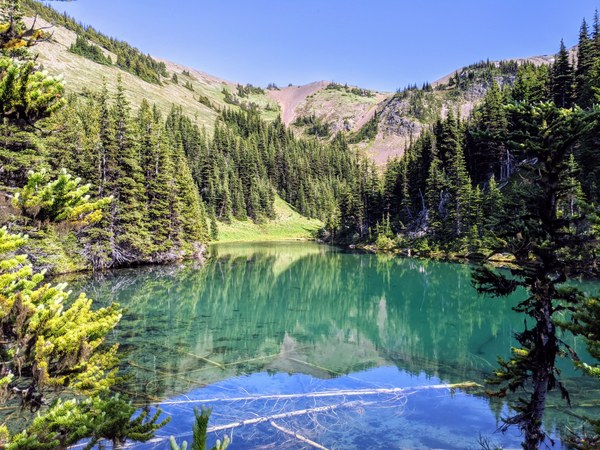
We began Day 2 by leaving the tarn by a different route than we had descended the afternoon before. It took us to Gray Wolf's northernmost subridge. Gray Wolf is another easy peak and requires little more than enjoyable T2 scrambling. We paused briefly at the top and made our way down the main ridgeline toward Gray Wolf South where things would soon become a lot more tough.
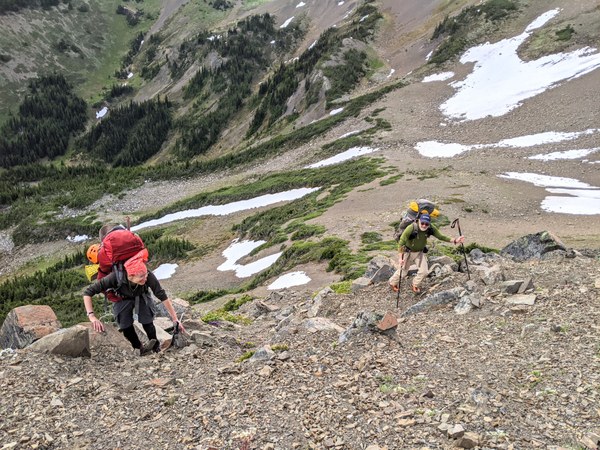
We took a few minutes on the summit of Gray Wolf South and headed down the ridge toward Mt. Walkinshaw. Getting past Walkinshaw and on toward the tarn we hoped to spend our second night at involved veering in a westerly direction from Gray Wolf Ridge, traversing game trails across the north side of Walkinshaw, and ascending a slope thick with heather and dense krumholtz. Our progress slowed to a crawl, but we fought our way through and finally emerged on a clear, smooth, snow-covered slope that we'd take for a couple thousand feet before dropping down steeply into a valley. We hoped the valley would provide a straightforward route to the tarn where we planned to camp. At this point, dusk was fast-approaching and our team was tired from a long and more exerting day than any of us had expected. The descent into the valley took longer than I thought it would, and when we reached what I'd been picturing as a pleasant creek that we could walk along toward our tarn with ease, we were instead greeted by a rocky, vegetated morass that didn't appear much more enjoyable to pick our way through than did the krumholtz of an hour or two previously. Fortunately, it soon began to seem that we had descended into the very thickest part of the morass - it only took 15 or 20 minutes of climbing over boulders and pushing through the brush and trees before we were moving considerably more quickly toward the tarn. By this time, however, dusk was upon us, and, coming across a flat clearing with the creek running beside us, we decided the tarn could wait. We set up camp.
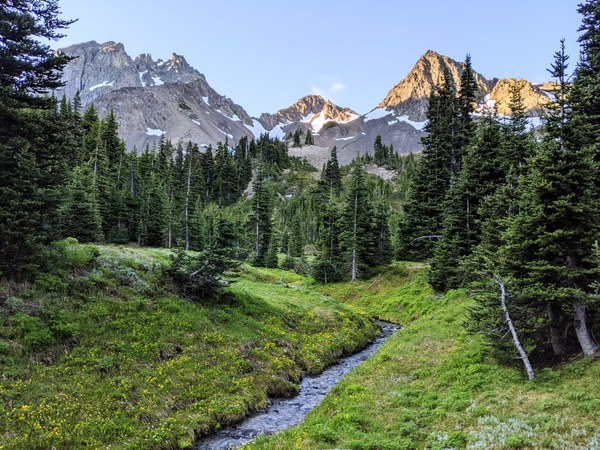
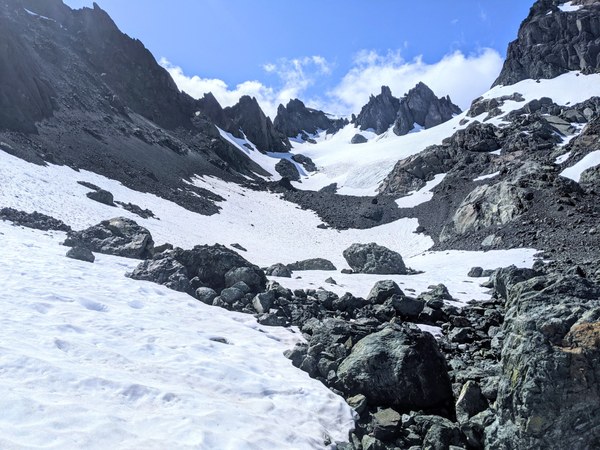
Once we got to our feet again, we traversed a bowl with a startlingly blue glacial lake at it's center and descended into Upper Royal Basin amid alien-looking boulders (possibly pillow basalt), cloud and fog, and portions of thick snow. 15.5 hours after heading out from our second night's camp, we spotted the beacon lamp the others in our team had considerately set out for us. We walked into camp, more than ready for a warm meal and a good night's rest.
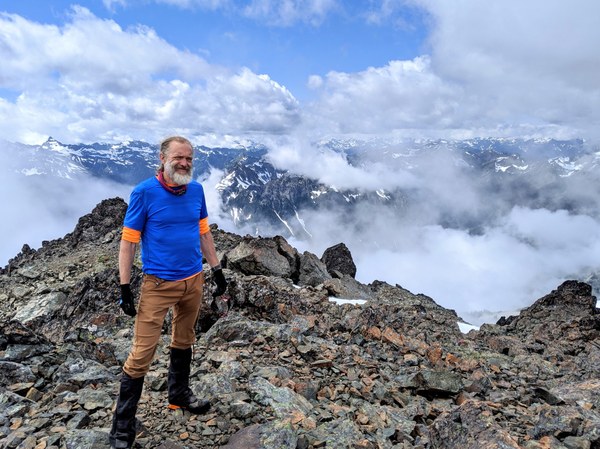
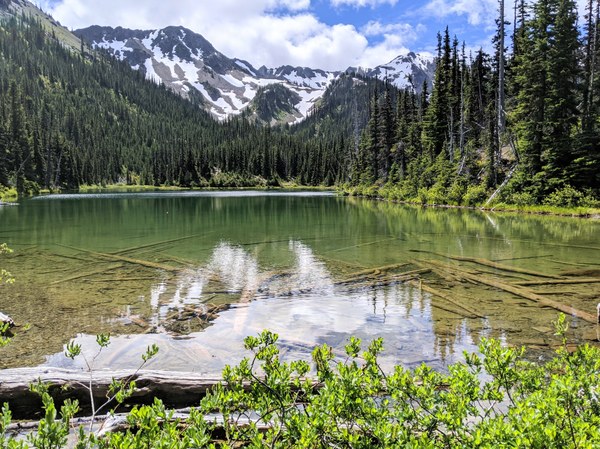
 Chad Marsh
Chad Marsh